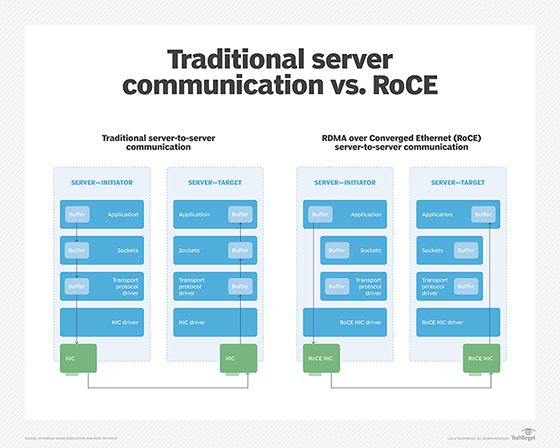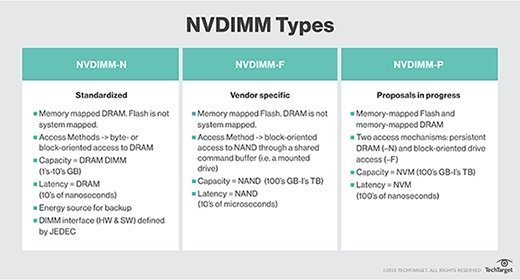Remote Direct Memory Access (RDMA)
What is Remote Direct Memory Access (RDMA)?
Remote Direct Memory Access is a technology that enables two networked computers to exchange data in main memory without relying on the processor, cache or operating system of either computer. Like locally based Direct Memory Access (DMA), RDMA improves throughput and performance because it frees up resources, resulting in faster data transfer rates and lower latency between RDMA-enabled systems. RDMA can benefit both networking and storage applications.
RDMA facilitates more direct and efficient data movement into and out of a server by implementing a transport protocol in the network interface card (NIC) located on each communicating device. For example, two networked computers can each be configured with a NIC that supports the RDMA over Converged Ethernet (RoCE) protocol, enabling the computers to carry out RoCE-based communications.
Integral to RDMA is the concept of zero-copy networking, which makes it possible to read data directly from the main memory of one computer and write that data directly to the main memory of another computer. RDMA data transfers bypass the kernel networking stack in both computers, improving network performance. As a result, the conversation between the two systems will complete much quicker than comparable non-RDMA networked systems.

RDMA has proven useful in applications that require fast and massive parallel high-performance computing (HPC) clusters and data center networks. It is particularly useful when analyzing big data, in supercomputing environments that process applications, and for machine learning that requires low latencies and high transfer rates. RDMA is also used between nodes in compute clusters and with latency-sensitive database workloads.
Network protocols that support RDMA
An RDMA-enabled NIC must be installed on each device that participates in RDMA communications. Today's RDMA-enabled NICs typically support one or more of the following three network protocols:
- RDMA over Converged Ethernet. RoCE is a network protocol that enables RDMA communications over an Ethernet The latest version of the protocol -- RoCEv2 -- runs on top of User Datagram Protocol (UDP) and Internet Protocol (IP), versions 4 and 6. Unlike RoCEv1, RoCEv2 is routable, which makes it more scalable. RoCEv2 is currently the most popular protocol for implementing RDMA, with wide adoption and support.
- Internet Wide Area RDMA Protocol. iWARP leverages the Transmission Control Protocol (TCP) or Stream Control Transmission Protocol (SCTP) to transmit data. The Internet Engineering Task Force developed iWARP so applications on a server could read or write directly to applications running on another server without requiring OS support on either server.
- InfiniBand. InfiniBand provides native support for RDMA, which is the standard protocol for high-speed InfiniBand network connections. InfiniBand RDMA is often used for intersystem communication and was first popular in HPC environments. Because of its ability to speedily connect large computer clusters, InfiniBand has found its way into additional use cases such as big data environments, large transactional databases, highly virtualized settings and resource-demanding web applications.

Products and vendors that support RDMA
A number of products and vendors support RDMA, among them:
- Apache Hadoop and Apache Spark big data analysis
- Broadcom and Emulex adapters
- Ceph object storage platform
- ChainerMN Python-based deep learning open source framework
- Chelsio Terminator 6 iWARP adapters
- Dell EMC PowerEdge servers
- FreeBSD operating system
- GlusterFS distributed files ystem
- Intel Xeon Scalable processors and Platform Controller Hub
- Marvell FastLinQ 45000 Series Ethernet NICs
- Nvidia ConnectX network adapters and InfiniBand switches
- Microsoft Windows Server (2012 and higher)
- Nvidia DGX deep learning systems
- Oracle Solaris and NFS over RDMA
- Red Hat Enterprise Linux
- SUSE Linux Enterprise Server
- TensorFlow open source software library for machine intelligence
- Torch scientific computing framework
- VMware ESXi
RDMA with flash-based SSDs and NVDIMMs
All-flash storage systems perform much faster than disk or hybrid arrays, resulting in significantly higher throughput and lower latency. However, a traditional software stack often can't keep up with flash storage and starts to act as a bottleneck, increasing overall latency. RDMA can help address this issue by improving the performance of network communications.
RDMA can also be used with non-volatile dual in-line memory modules (NVDIMMs). An NVDIMM device is a type of memory that acts like storage but provides memory-like speeds. For example, NVDIMM can improve database performance by as much as 100 times. It can also benefit virtual clusters and accelerate virtual storage area networks (VSANs).
To get the most out of NVDIMM, organizations should use the fastest network possible when transmitting data between servers or throughout a virtual cluster. This is important in terms of both data integrity and performance. RDMA over Converged Ethernet can be a good fit in this scenario because it moves data directly between NVDIMM modules with little system overhead and low latency.

NVM Express over Fabrics using RDMA
Organizations are increasingly storing their data on flash-based solid-state drives (SSDs). When that data is shared over a network, RDMA can help increase data-access performance, especially when used in conjunction with NVM Express over Fabrics (NVMe-oF).
The NVM Express organization published the first NVMe-oF specification on June 5, 2016, and has since revised it several times. The specification defines a common architecture for extending the NVMe protocol over a network fabric. Prior to NVMe-oF, the protocol was limited to devices that connected directly to a computer's PCI Express (PCIe) slots.

The NVMe-oF specification supports multiple network transports, including RDMA. NVMe-oF with RDMA makes it possible for organizations to take fuller advantage of their NVMe storage devices when connecting over Ethernet or InfiniBand networks, resulting in faster performance and lower latency.






